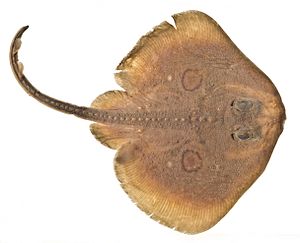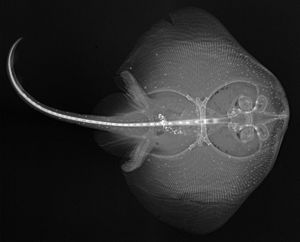Pacific starry skate facts for kids
Quick facts for kids Pacific starry skate |
|
|---|---|
 |
|
 |
|
| Conventional and X-ray images | |
| Conservation status | |
| Scientific classification | |
| Synonyms | |
|
The Pacific starry skate (scientific name: Raja stellulata) is a type of fish. It's also known as the rock skate, prickly skate, or just starry skate. This amazing creature is a species of cartilaginous fish, which means its skeleton is made of cartilage, not bone. It belongs to the Rajidae family.
You can find these skates living on the ocean floor. They prefer rocky areas in the Northeast and Eastern Central Pacific Ocean. Their home stretches from northern Baja California in Mexico all the way up to Barkley Sound in British Columbia, Canada. They usually live in deep, cold water, often between 70 and 150 meters down.
Female starry skates can grow up to about 76 centimeters long and live for about 15 years. Males are a bit smaller, reaching about 71 centimeters, and can live for up to 14 years. When they are born, these skates are already about 15 to 22 centimeters long!
Contents
What Does the Starry Skate Look Like?
Pacific starry skates have some cool features. They have a line of strong spines running down the middle of their back. You'll also see larger spines on their "shoulders."
Around their eyes, they have a row of smaller spines. There are also groups of medium-sized spines along the edge of their pectoral fins. Male starry skates even have one large spine.
Their dorsal (top) and caudal (tail) fins are small. They don't have an anal fin. Their pectoral fins are wide and connect to their snout, blending into their body. Their pelvic fins are large and have a deep notch.
Starry skates also have a fleshy ridge on their underside, running from each side to their tail. This ridge is more noticeable towards the tail. Their bodies are usually grayish-brown with many dark spots of different sizes. Sometimes, they have faint eye-like spots near their pectoral fins.
Where Do Starry Skates Live?
Starry skates love to live on hard surfaces near rocky reefs. While they can sometimes be found on soft sand or mud, they much prefer rocky areas.
They live in a wide range of depths, from as shallow as 18 meters to as deep as 982 meters. However, they are most commonly found in depths between 70 and 150 meters. They like cold water, usually between 4.1 and 11.6 degrees Celsius.
Reproduction and Life Cycle
The starry skate reproduces by laying eggs. This means they are oviparous. Their egg cases are ribbed and have long, strong horns.
Starry skates can reproduce all year long, so there isn't a specific breeding season. When they hatch, young skates are about 15.5 to 22.5 centimeters long. Baby skates often follow large objects, which might be their mothers.
Female skates become able to reproduce when they are about 47.4 centimeters long and around 9 years old. They are fully mature when they reach about 69.2 centimeters in length and are 15 years old.
Male skates can start reproducing when they are about 46.0 centimeters long and 6 years old. They are fully mature when they are about 65.8 centimeters long and 13 years old. The time it takes for a generation of starry skates to grow and reproduce is typically 8 to 12 years.
Where Are Starry Skates Found?
You can find Raja stellulata from the Bering Sea down to Northern Baja California. However, some scientists think the skates in the Bering Sea might be a different species. If that's true, then the northernmost place to find the Pacific starry skate would be Barkley Sound in British Columbia, Canada.
What Do Their Names Mean?
The genus name, raja, comes from a Latin word for stingray. The species name, stellulata, is also from Latin. It means "small star," which probably refers to the starry spots on their bodies.
See also
 In Spanish: Raja stellulata para niños
In Spanish: Raja stellulata para niños


